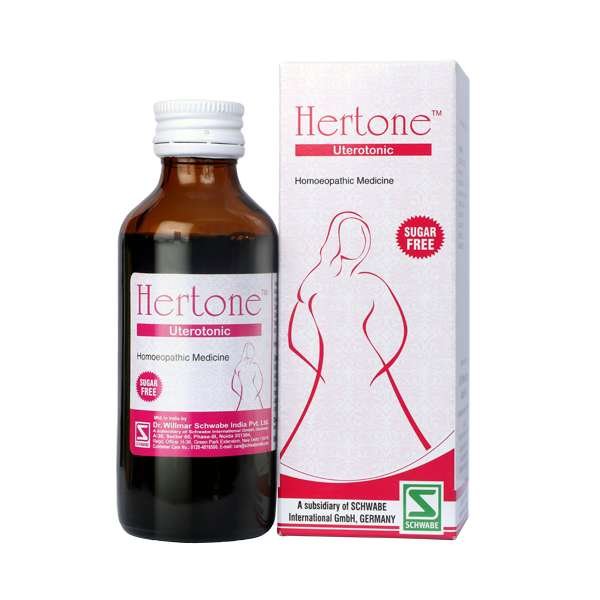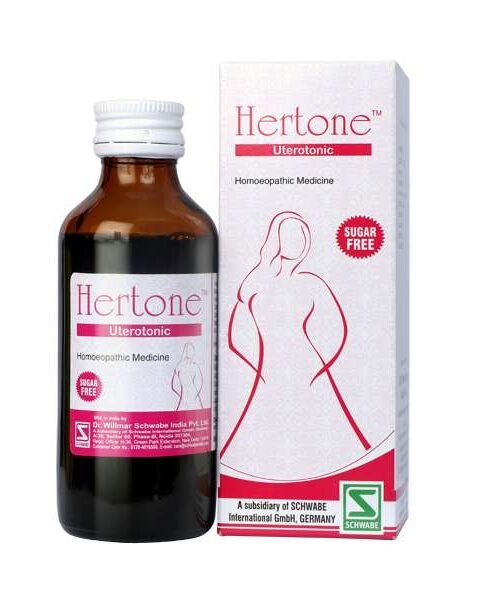Introduction
Hertone? is a new product developed by Schwabe. Clinical problems of female sex are varied. Scientist have taken care to develop a non-toxic formulation with wide coverage. Inputs for need of such a product covered from simple menstrual disturbance and dysmenorrhoea to complicated conditions like ovarian cyst (also called as polycystic ovarian disease/syndrome or PCOD/PCOS) and uterine fibroids. Though genetics plays a role in developing these problems, modern researchers link it to the badly behaved hormones: estrogen, progesterone and others. Experts in the field explain how our modern day lifestyle affects these hormones and end up in many of these problems. As a result, symptoms of imbalanced hormones well before developing any of these specific ?disorder? are felt. Subsequently these problems develop after sometime. Initially there may be slight disturbance in the menstrual cycle and nature of pain during menses. These may be associated with general symptoms like sleeplessness, pedal oedema, poor appetite, weight gain, etc. Over a period of time these develop as disorders of female reproductive system.Hertone ? is a product which covers different stages of such disorders.
The disorders of female reproductive system have been grouped (a) menstrual disturbances, (b) vaginal discharges, and (c) growths & cysts. Hertone? is indicated in menstrual disturbances including amenorrhoea (secondary), menorrhagia, metrorrhagia and dysmenorrhoea. Abnormal vaginal discharge such as leucorrhoea of different types is covered by Hertone?. It also covers uterine fibroid and ovarian cyst with intermittent or continuous pain which may be mild to severe intensity in lower abdomen. Pain in uterine fibroid is more often generalized. Pain of ovarian origin is usually felt at ovarian regions or sides (iliac fossae). The product covers endometriosis, which is an abnormal endometrial growth on ovary and tissues lining the pelvis.
The formulation strengthens the female reproductive organs. Hertone ? has 6 ingredients which have scientific proving for their role in female reproductive system. Apart from their traditional use, the modern research on them recommends their use. It is recommended for functional tone up of female reproductive system. The ingredients act as uterotonic, anti-inflammatory, emmenagogue, estrogenic, anti-spasmodic, androgenic, uterosedative and others.
Composition:
Each 100ml contains:
Abroma radix ? HPI 5% v/v
Aletris farinosa ? HPUS 5% v/v
Caulophyllum thalictroides ? HPI 1% v/v
Cimicifuga racemosa ? HPI 1% v/v
Helonias dioica ? HPI 3% v/v
Janosia ashoka ? HPI 5% v/v
Alcohol content 11.5% v/v
Excipients: QS
?
|
Indications: Uterine tonic. Covers amenorrhoea, menstrual irregularities such as menorrhagia, dysmenorrhoea. It is used for ovarian cyst, uterine fibroid, and endometriosis. It is also used in associated water retention, insomnia, debility, anxiety, rectal distress, constipation, and cases of infertility. Symptoms of premenstrual syndrome (PMS) like mood swings, tender breasts, food cravings, fatigue, irritability and depression are also covered. |
Proven indications of the individual ingredients in the sphere of claimed action:
Abroma radix: It is an uterine tonic and emmenagogue, given in congestive and neuralgic dysmenorrhea (as a sedative), amenorrhoea and leucorrhoea. It is useful in albuminurea, sleeplessness and debility.
Aletris farinosa: This remedy has special affinity towards female organism. Its oestrogenic action is well proved. Premature and profuse menses with labour like pain. Useful for dysmenorrhea and irregular threatened abortions. It is one of the important remedies for infertility. It is used as a general tonic due to its action like a sedative to promote relaxation. It covers debility, joint and muscle pains during menses, prolapsus, leucorrhoea, fluid retention, colic, stomach upset, constipation, rectal distress, diarrhoea, etc. Also used in anaemia in young girls.
Caulophyllum thalictroides: It acts like a tonic. This agent acts upon the uterus as an emmenagogue and parturifacient (an agent that induces or accelerates labour, hence it is used during labour, when the pains are deficient and the patient is exhausted and fretful). It also acts upon the muscles & small joints. It is used for pain in such joints during menses. In some cases of menopause, pain of joint is associated. It can safely be used there also. Useful in chronic acric leucorrhoea and associated exhaustion. It is reported to control the haemorrhage that follows labours, and haemorrhage that accompanies abortions. Possesses antispasmodic, anti-inflammatory, anti-rheumatic and diuretic activities.
Cimicifuga racemosa: It acts upon the uterus and ovaries. Especially useful in ovarian irritation, uterine cramps and heavy limbs. Covers muscular and crampy pains, primarily of neurotic origin. Used in dysmenorrhoea with backache which occurs in people with irregular menses. Pain immediately before menses. Pain in ovarian region, radiating downward especially to the anterior surface of thigh and it shoots upwards as well. Pain across pelvis, from hip to hip. Infra-mammary pains. Facial blemishes (mark or spot affecting appearance) in young women. Recent clinical evidence supports the efficacy and safety of this drug for symptoms of premenstrual tension, menopause and other gynecological problems, complications associated with childbirth.
Helonias dioica: Its chief action is to improve the tone of the reproductive organs. It has also been used traditionally for dysmenorrhoea, amenorrhoea, leucorrhoea, prolapse with disordered menstruation and to improve libido. It is regarded primarily as a uterine tonic. It is reported to be useful to prevent miscarriages. Its action is known on the ovaries as well. Hence it is used in pelvic inflammation and to improve fertility. It also covers prolapse of uterus (due to weakness) and other malposition of the womb. Used in cases of ovarian cysts, suppressed menses and congested kidneys. Considered useful during menopause. Modern literature supports its use to treat problems as menstrual problems, pregnancy complaints, fertility issues, ovarian cysts and as diuretic.
Janosia ashoka: It has extensive sphere of action on female organs. It is used in cases of amenorrhoea for regulating rhythm and flow, and metrorrhagia. Research has shown that it possesses oxytocic, stimulant, spasmogenic action on uterus. Its phytoconstituent saracin is seen as immunomodulator, and the drug as a whole good for female reproductive system. Recent studies have found it to possess antimenorrhagic, anti-inflammatory, antioxytocic, analgesic and uterine tonic activities.
Dosage: Unless otherwise prescribed, Hertone ? should be taken as follows: 1-2 teaspoon 2-3 times daily.
Side effects: No side effect of Hertone ?, are known.
Contra-indications: No contra-indications for the use of Hertone ?, are known.
Caution: To be used under medical supervision in cases of pregnancy.
Interactions: No interactions between Hertone ?, and other products are known.
Presentation: Bottle of 100 ml.?









Reviews
There are no reviews yet.